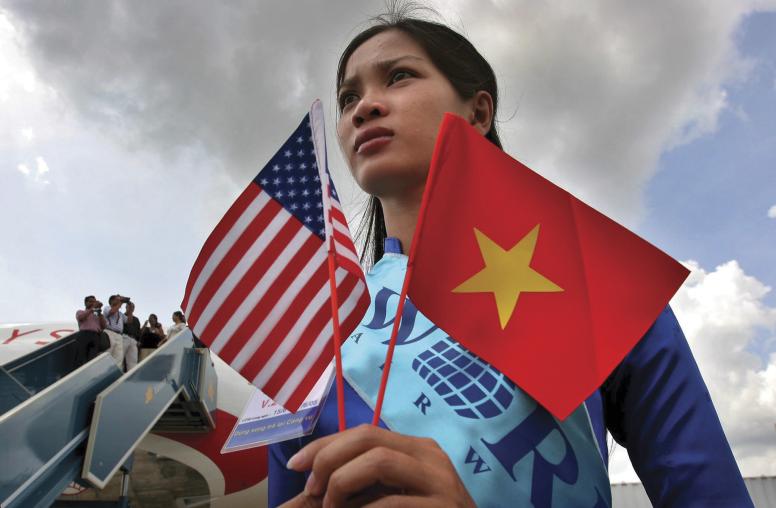When Nguyễn Xuân Thắng was young, he developed a passion for researching various documents, military studies, maps and weapons related to the Vietnam War. Eventually, he realized he could use these records to search for the remains of his maternal uncle, one of the many fallen North Vietnamese soldiers — or “martyrs,” as they are referred to in Vietnam — that were buried in unknown locations.

While searching for his uncle, he discovered that there were detailed records of where many other North Vietnamese soldiers had fallen. This led him to believe that there must be more evidence and documentation to help find the location of their graves as well. Thắng has dedicated the past 20 years to this pursuit.
Not Searching Alone: A Growing Movement
The process of finding these graves wasn’t clear-cut or simple. “Our war was long, and historical records today do not document everything fully and clearly,” said Thắng. This gap in formal information prompted him to search for and collect information and images from various forums, websites, groups, and documents from both domestic and foreign sources. He posted useful information on his personal website and social media — and quickly found that he was not alone.
Thắng connected with other Vietnamese trying to find burial sites. They began sharing resources — and even received useful contributions from former South Vietnamese soldiers about possible locations of their former enemies’ graves.
Thắng and his volunteer group’s efforts have identified the presumed locations of mass graves that may contain up to 20,000 fallen soldiers.
In most cases, the battle sites have changed a great deal over the past five decades. However, comparing wartimes maps, photographs and personal memories with modern satellite imagery and other new technologies, this unlikely collaboration is having some noteworthy success: Today, Thắng and his volunteer group’s efforts have identified the presumed locations of mass graves that may contain up to 20,000 fallen soldiers.
Over the last 10 years, Thắng and his partners have also been joined by a small but dedicated group of American veterans who have taken up the cause. Among this cadre of veterans are Richard Magner, Bob Connor and Kin Lo, all of whom helped pioneer the search for mass graves of North Vietnamese soldiers.
A Surprise Connection
Bob Connor first came to Vietnam in April 1967 as a young Air Force security policeman assigned to Biên Hòa Air Base. He saw combat — and like many other American veterans, wanted to put his memories of Vietnam behind him.
But years later, his granddaughter asked for help with a school project on Vietnam, which got him thinking about the country and his experiences again. He began looking up familiar locations on the internet and found a website used by Thắng with a photo taken at Biên Hòa Air Base in 1968. Connor immediately left a comment: “At this location is a mass grave of approx 150 VC/NVA Soldiers buried on or about Feb 2, 1968 as a result of the Tet ’68 battle.”
This post was spotted separately by Vietnamese veterans Chế Trung Hiếu and Colonel Mai Xuân Chiến, who contacted Connor to request more information and any additional witness accounts regarding the whereabouts of the gravesite. They also linked Connor to Thắng and other Vietnamese and American researchers.
This sparked further exchanges, and in March 2016, Connor, along with his former commander, Colonel Martin E. Strones, returned to Vietnam on a noble mission. Walking on the same path that he took 49 years earlier, he and Strones were able to point out the location of one of the mass graves, where the remains of 80 individuals were excavated.
A solemn memorial ceremony was held in July 2017. Although he could not attend, Connor watched a video of the event — and when he saw the red, tearful eyes of a woman who was reunited with her loved one after 49 years, he knew his work was not finished.
When [Bob Connor] saw the red, tearful eyes of a woman who was reunited with her loved one after 49 years, he knew his work was not finished.
After fighting in a battle roughly 10 kilometers from Xuan Son in December 1966, Kin Lo and other members of the U.S. 1st Cavalry were moved to LZ Bird to guard the perimeter and recuperate. One night shortly after Christmas, they came under attack from more than 2,000 North Vietnamese and Viet Cong soldiers. Lo recalled the many casualties on both sides, adding that the United States was able to “recover our dead, but the enemy left their ‘martyrs’ on the battlefield, and we buried them in the two mass graves.”
Many years later, Lo learned that veterans with knowledge of the battle were being asked to help find the gravesites.
“It was difficult to recognize anything when we went back,” he said. “The firing pits, bunkers and trenches were all gone. However, with the help of my fellow veterans, we were able to pinpoint the location of one of the mass graves, and are still looking for the other.”
Not all the American veterans have seen their efforts yield success, however. A few days after the end of the battle at Dầu Tiếng on February 22-23, 1969, Army Warrant Officer Richard Magner — a Cobra attack helicopter pilot with the 1st Cavalry — took aerial photos that included a North Vietnamese mass grave in the northeast of the base camp. He later learned that several fellow pilots also saw the grave site and took photos. However, none of the images had identifying features or landmarks that might indicate its exact location.
Many years later, Magner is intimately engaged with Thắng and others to find the site, which has remained elusive: “Thang and I worked tirelessly for seven years to find the tomb.”
Since they began, Magner, Connor, Lo and their fellow veterans have identified the burial places containing thousands of possible remains — and have no plan to stop any time soon. “Our memories are long and strong,” said Connor. “And there are more waiting to be found.”
However, some of the locations provided by American veterans are very difficult to access and excavate, and the geological terrain has changed a lot, making the process of identifying the sites and retrieving the remains increasingly difficult.
Meanwhile, Magner acknowledges that both the American and Vietnamese veterans and other witnesses who knew of the existence of mass graves are getting old. “Everyone is eager to race against time to bring their ‘brothers’ back home,” said Magner. “My sincerest desire is that the discovery of these tombs in the future will free lost souls, bringing comfort to their families and loved ones."
"I consider Vietnamese soldiers as brothers,” added an emotional Magner. “I sincerely want to find my brothers."
How the U.S. Can Help
Over the years, both the U.S. and Vietnamese governments have become increasingly interested in the search for missing soldiers as a way to gradually heal the bilateral relationship. And for American veterans like Magner, Connor and Lo, returning to search for mass graves is driven by a desire to comfort the souls of the dead and ease the pain of the living.
In June 2024, a delegation including these three American veterans came to Vietnam to participate in activities that were sponsored by USIP and coordinated with the Vietnam Union of Friendship Organizations and the Vietnam Martyrs’ Families Support Association to share research results on the locations of mass graves.
The visit was organized by USIP as part of the Vietnam Wartime Accounting Initiative — the U.S. government program to assist Vietnam in finding fallen and missing soldiers. The central role of veterans from both countries in leading search efforts is a unique feature of postwar U.S.-Vietnam relations that has built people-to-people ties among Vietnamese and Americans and made former warriors into peacebuilders.
The veterans conducted meetings and site visits from Hanoi in the north to Ho Chi Minh City in the South. They also provided local military command authorities with a large number of documents gathered from and verified by many witnesses who participated in battles at former U.S. bases.
And for Magner, the trip reignited hope for more discoveries. After an excavation survey in December 2018 failed to locate the mass grave he photographed nearly five decades earlier, he and four other people returned to the Dầu Tiếng area this summer. They conducted a new survey on June 23, 2024, and identified a sunken location and that they now believe may be the location of the grave.
Many families have found their lost relatives and obtained information through the efforts of Nguyễn Xuân Thắng and the American veterans who have returned to Vietnam and shared their knowledge. But not all families are so fortunate as of yet, so the search continues.
Huyen Cung is a Vietnamese journalist.
U.S. and Vietnamese veterans who possess information or artifacts relating to losses from the war are invited to contact USIP at vietnam@usip.org or veterans’ organizations in either country to help further the work of postwar reconciliation.



